Passion Cross on Ash Wednesday Chalice Veil
Passion Cross on Ash Wednesday Chalice Veil
Finally, it is time to start a new Ecclesiastical Sewing project for the New Year. The first project in the works is the Chalice Veil for Passion Cross on Ash Wednesday.
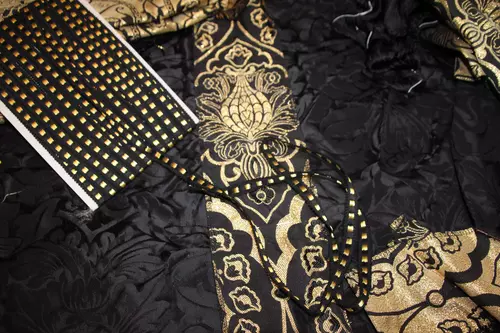
The fabrics and trims are all decided………..well, almost all decided. The chalice veil will be the black Fairford fabric, with the Black and Gold Wakefield used as the orphrey. The black/gold dice trim will edge the orphrey. The only minor issue is how to easily let the altar guild and Pastor know the correct positioning of the chalice veil when it is in use.
The simple answer is to add a cross on the front. But a simple answer can also raise a host of further questions. For example, what type of cross should be used?
Ecclesiastical Crosses
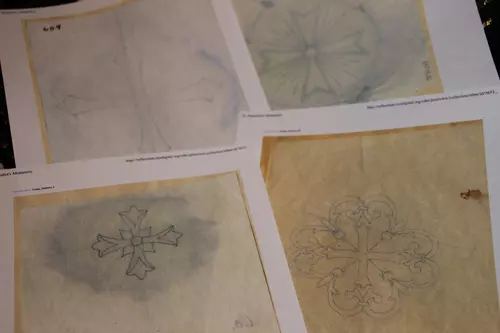
Crosses are pretty basic, right? One is the same as the next. Easy task, or so I thought. I reviewed a file with over 160 cross designs, and nothing, not an iota, not a dot, seemed like it was the right cross design. The crosses were too fancy, too complex, too simple, too large, too small, wrong scale, and on and on. This will never do. So how does one find the correct cross for use on an Ecclesiastical Embroidery project? It was time to pull out the symbol books. Luckily, a few new ones had recently arrived.
Church Symbolism
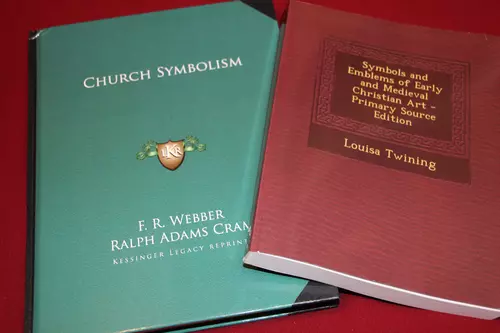
The first is Church Symbolism by F.R. Webber and Ralph Adams Cran, originally published in 1938 and a reprint of the original text. I had noticed this book referenced in the bibliographies of several work other works. Those authors referred to Church Symbolism with favorable comments. Unable to find the book readily available online, we ordered the reprint from Amazon.
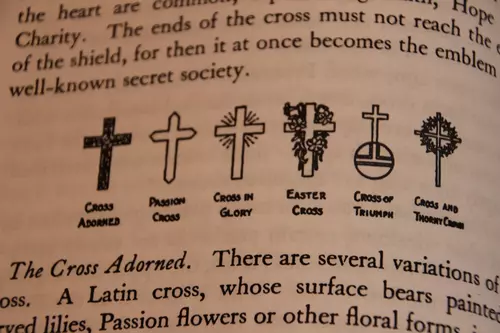
The book has a wonderful, useful index that makes locating a subject easy. The information presented is detailed and thorough. This is not just a mere snippet or sound bite on a topic as is the case in more modern texts on the subject of Christian Symbols. The chapter on crosses has little illustrations depicting a vast array of cross examples. The above grouping caught my eye with the words “Passion Cross.” Could this be the cross I had been hunting for?
The description for Passion Cross is as follows:
This is a cross whose ends are cut to points. It is also known as the Cross Urdee, and the Cross Champain, sometimes the Cross Pointed. It represents the sufferings of our Lord and has been called by some authorities the Cross of Suffering. If pictured as rising out of a chalice, it represents our Lord’s agony in the Garden of Gethsemane. It may be used as a symbol of Maundy Thursday, or of Good Friday.
The second book, Symbols and Emblems of Early and Medieval Christian Art by Louisa Twining is available online in some locations. This is also a great reference book, but not for this particular project.
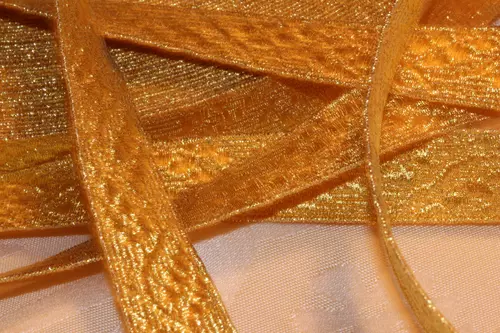
The Passion Cross Execution
Now that the Passion Cross decision is made, the next question is a matter of execution. The options for working the cross are black embroidery floss with gold couching on the Wakefield fabric, or a gallon trim used to make the Passion Cross. There are several considerations before making a final choice for the Passion Cross materials. The first is how the gold gallon looks on the black fabric. It may be too gold.
The set is somber and should not be the glorious, shiny, celebratory gold of Easter morn. There needs to be a stark contrast between the materials used for both occasions. The other concern deals with the scale of the cross. Although the cross on the Chalice Veil will be small, the same style of the cross may also be used on some large banners. The gold gallon is limited to a 2″ width, which may not be the correct size scale for use on a large banner.
Of course, there is also option number three: no cross. No one is going to be concerned about the direction of the design on the orphrey and chalice veil fabric except me.
It is time to pull out a few items, look and contemplate, and then sleep on the ideas. Things usually clear up in the morning or after a few days.
Solo Dei Gloria
Be sure to visit our online store front Ecclesiastical Sewing where you may shop for Liturgical Fabrics, altar linen fabrics, church vestment-making patterns, liturgical machine embroidery designs, church vestment trims and notions and so much more. You may also find us on Ecclesiastical Sewing on Facebook, Twitter, and Pinterest. Sign up for our mailing list at the bottom of the page on our online store front and receive a free copy of our Small Linens Booklet as our way of saying thank you for following along.
Chalice Veil Design from Althea Wiel
Chalice Veil Orphrey Trim Part 2
Black and Gold Vestments: Making a Chalice Veil
Symbols of Lent: Penitence to Hope
Symbolism in the Church: The Cross
Rose Chalice Veil Construction






 RSS - Posts
RSS - Posts
Hi, Im new to your site and have been asked by my priest to sew some chalice veils and aer for the nativity. Im having a hard time finding galloons and fringe, and even decent iron-on applique crosses. Do you have a source you use frequently for these sorts of things? Im not a professional or even highly experienced and sewing, but I need to do a good job =). Thanks for your help.
Hi,
Soon, I will have an assortment of galloons and fringe available when my new storefront opens.
I will email you privately to find out more about the specifics of your project, and how you might best find the items needed.
Best regards,
Carrie
Hi Carrie…interesting that the Lutheran Church uses black for Ash Wednesday…never heard of it until now. In the Roman Rite we only use black to express mourning (i.e. funerals and Good Friday) though black is rare today with North America preferring to now use white for funerals while Europe prefers the use of purple. As for Black vestments used for Good Friday this was changed by Rome to red to signify Christ’s martyrdom.
The LCMS follows the basic color rite, except for a few occasions. Ash Wednesday and Good Friday are one time. There are a few others that might be slightly different. It really is quite something to have the somber reality of black on Good Friday evening. The cross is veiled in black, the lights are dimmed, the service concludes with the Strepitus, a loud noise, signifying the rolling of the stone into place at the door of Jesus’ tomb. Everyone leaves in silence.
With regards to Black for Funerals, I am trying to find historical documentation that Black was the preferred color for funeral, rather that the modern use of the color of the liturgical season. My pastor is open to the idea, but would like historical confirmation that this was the practice of the church.
Sorry but a black veil for Ash Wednesday? The correct colour would be purple at least among Roman Catholics and Anglicans?
Yes, purple may be the correct color for many church bodies for Ash Wednesday. However, my church is Lutheran Church-Missouri Synod, and rubrics call for Black vestments and hangings for Ash Wednesday. For the most part, we follow the Roman Rite for colors, with slight variations on certain days. This is one of those variations. Often times in the past when black vestments and hangings were called for, purple was an appropriate alternative if there were no black vestments available.
the black and gold are yummy whatever you do with them
Yes, they do make a striking combination.